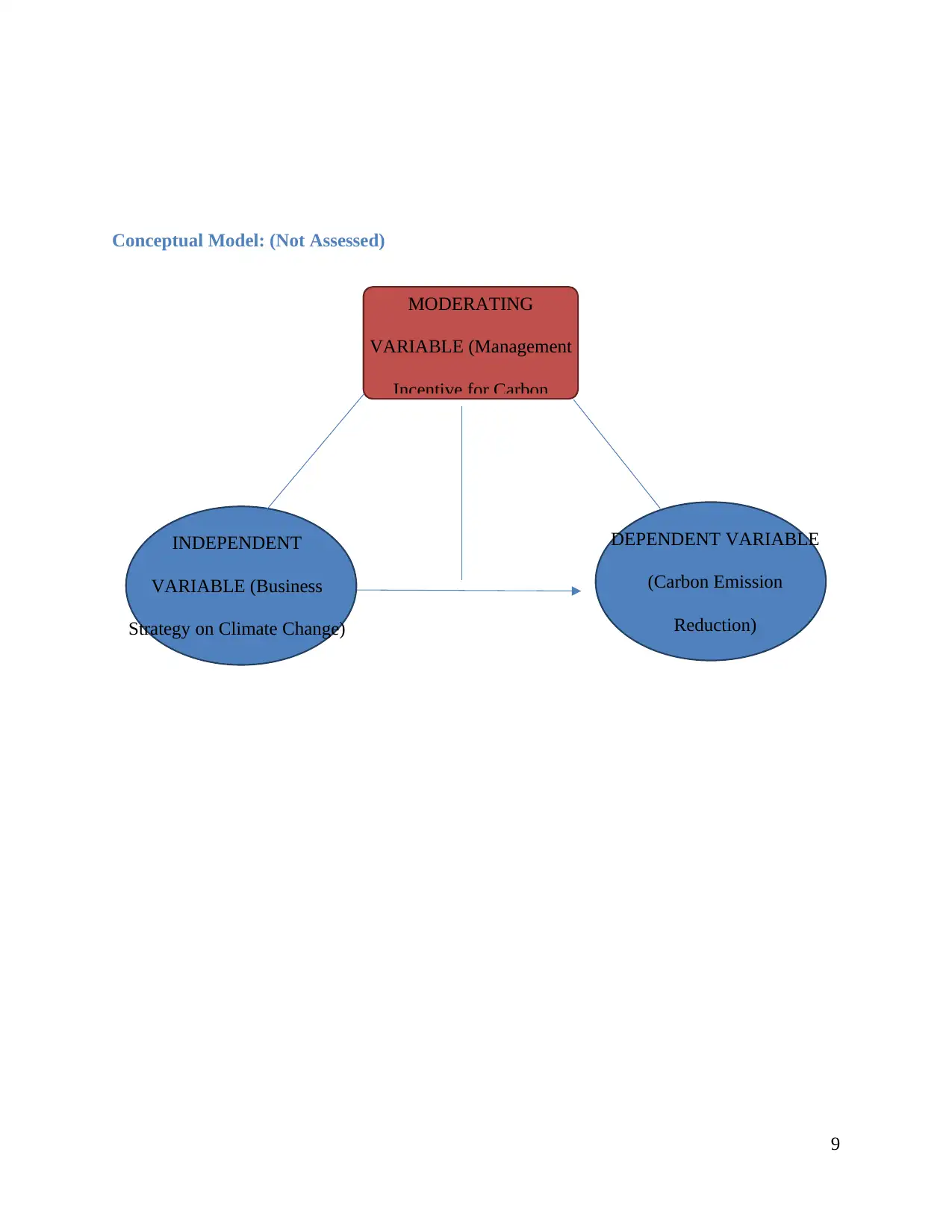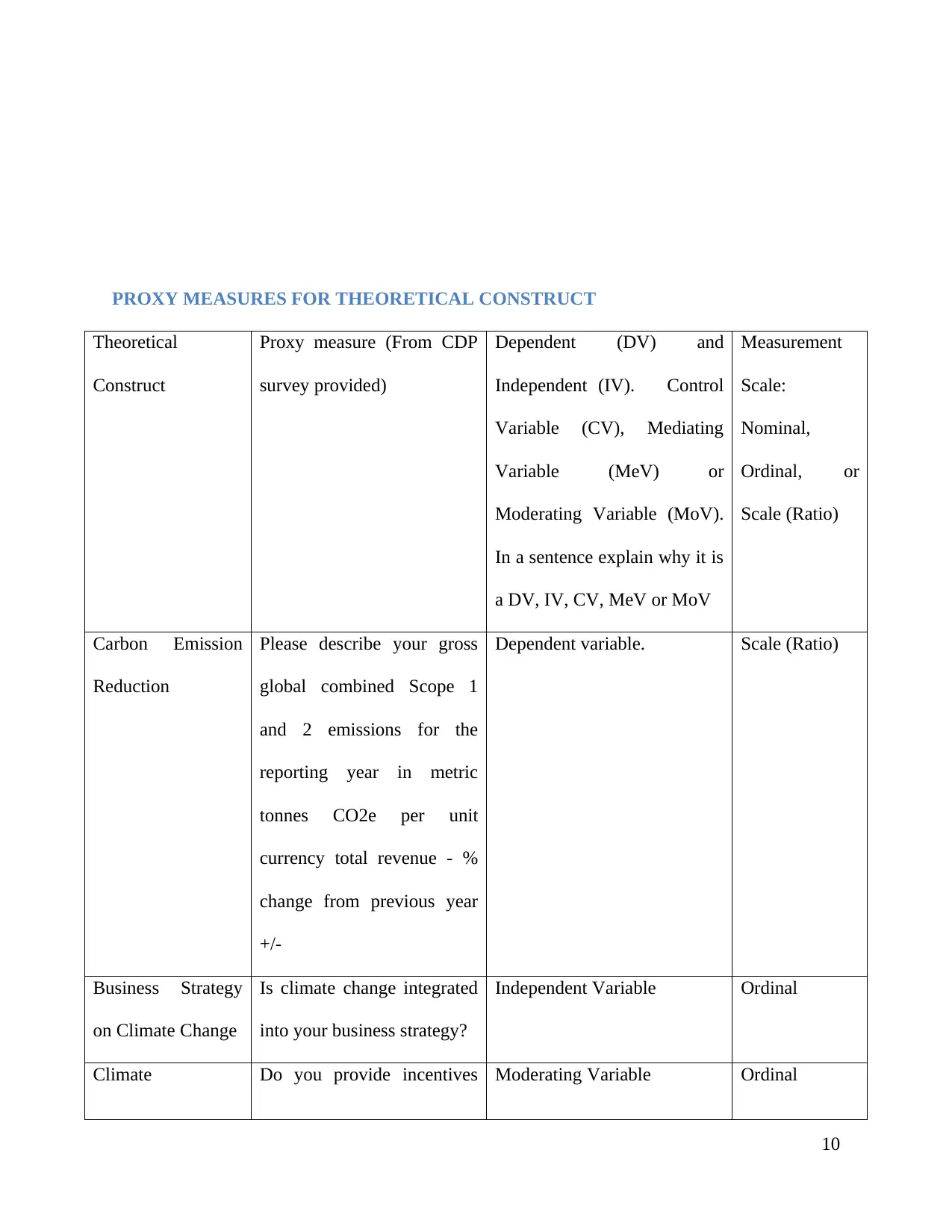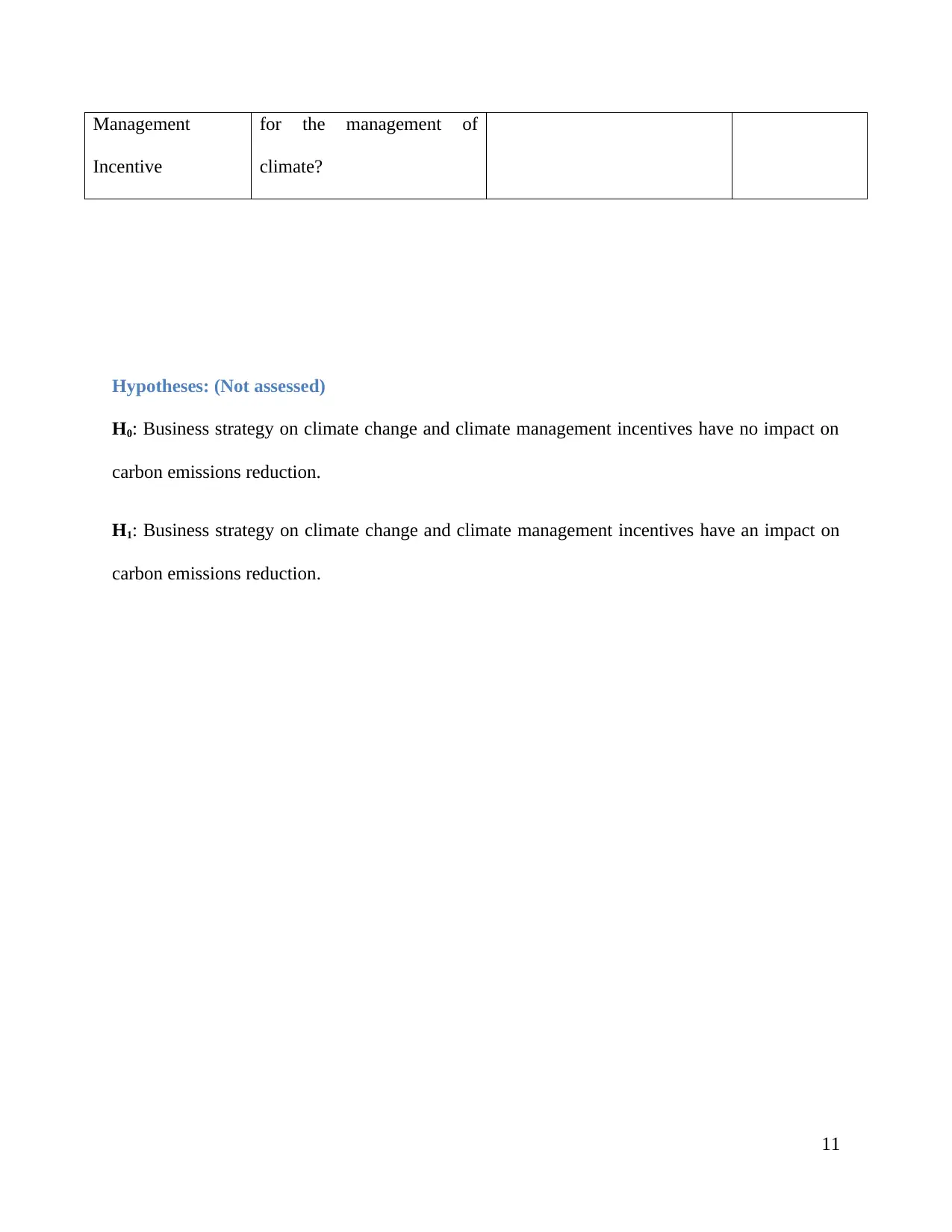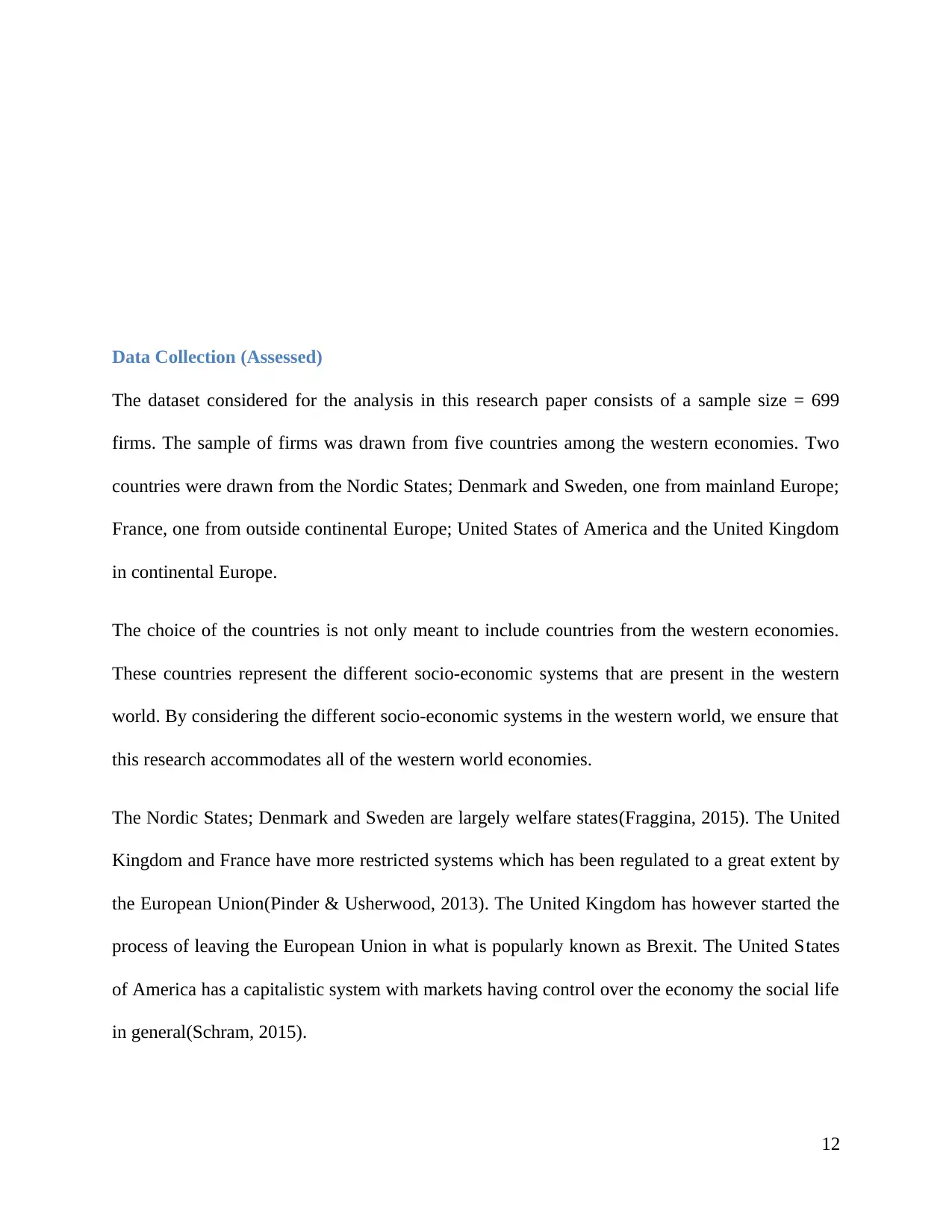MGT723 Research: Climate Change, Incentives & Carbon Emission
VerifiedAdded on 2023/06/03
|37
|6569
|365
Report
AI Summary
This research report investigates the impact of business strategies on climate change and climate management incentives on carbon emission reduction, focusing on five western countries: Denmark, Sweden, France, the United States of America, and the United Kingdom. The study uses a dataset of 699 firms across various industries to analyze the relationship between integrating climate change into business strategies, providing climate management incentives, and the resulting carbon emission reductions. Descriptive statistics reveal that a significant majority of firms have integrated climate change into their strategies, while a smaller portion offers climate management incentives. Inferential statistical analysis is conducted to test the hypothesis that business strategies and incentives impact carbon emissions. The report concludes with a discussion of the implications for practice and theory, limitations of the study, and suggestions for further research. This report is available on Desklib, where students can find similar solved assignments and past papers.

MGT723 Research Project
Semester X 20XX
Assessment Task 3: Report
Student Name:XXXXX
Title:XXXXX
Submission Date:XXXXX
(Note that the submission is due by 5:00pm via SafeAssign)
Acknowledgement:
I certify that I have carefully reviewed the university’s academic misconduct policy. I understand
that the source of ideas must be referenced and that quotation marks and a reference are required
when directly quoting anyone else’s words.
1
Semester X 20XX
Assessment Task 3: Report
Student Name:XXXXX
Title:XXXXX
Submission Date:XXXXX
(Note that the submission is due by 5:00pm via SafeAssign)
Acknowledgement:
I certify that I have carefully reviewed the university’s academic misconduct policy. I understand
that the source of ideas must be referenced and that quotation marks and a reference are required
when directly quoting anyone else’s words.
1
Paraphrase This Document
Need a fresh take? Get an instant paraphrase of this document with our AI Paraphraser

2

Table of Contents
Introduction: (Not assessed)........................................................................................................5
Literature Review– Summary (Not Assessed)............................................................................7
Conceptual Model: (Not Assessed).............................................................................................9
PROXY MEASURES FOR THEORETICAL CONSTRUCT.............................................10
Hypotheses: (Not assessed).......................................................................................................11
Data Collection (Assessed)........................................................................................................12
Data Analysis - Descriptive: (Assessed)....................................................................................14
Independent Variable.............................................................................................................14
Dependent Variable...............................................................................................................16
Moderating Variable..............................................................................................................17
Normality...............................................................................................................................19
Independent and Dependent Variables..................................................................................22
Data Analysis - Inferential: (Assessed).....................................................................................26
Data Analysis (Inferential)............................................................................................................27
Hypothesis testing..........................................................................................................................27
Discussion and conclusion.............................................................................................................31
Research Limitations.....................................................................................................................34
Further Research............................................................................................................................35
References......................................................................................................................................36
3
Introduction: (Not assessed)........................................................................................................5
Literature Review– Summary (Not Assessed)............................................................................7
Conceptual Model: (Not Assessed).............................................................................................9
PROXY MEASURES FOR THEORETICAL CONSTRUCT.............................................10
Hypotheses: (Not assessed).......................................................................................................11
Data Collection (Assessed)........................................................................................................12
Data Analysis - Descriptive: (Assessed)....................................................................................14
Independent Variable.............................................................................................................14
Dependent Variable...............................................................................................................16
Moderating Variable..............................................................................................................17
Normality...............................................................................................................................19
Independent and Dependent Variables..................................................................................22
Data Analysis - Inferential: (Assessed).....................................................................................26
Data Analysis (Inferential)............................................................................................................27
Hypothesis testing..........................................................................................................................27
Discussion and conclusion.............................................................................................................31
Research Limitations.....................................................................................................................34
Further Research............................................................................................................................35
References......................................................................................................................................36
3
⊘ This is a preview!⊘
Do you want full access?
Subscribe today to unlock all pages.

Trusted by 1+ million students worldwide

4
Paraphrase This Document
Need a fresh take? Get an instant paraphrase of this document with our AI Paraphraser

Introduction: (Not assessed)
There has been an increased awareness of the dangers posed by climate change. This has forced
people globally to rethink their approach in life and business so as to mitigate the effects of
climate change. Among these people are the stakeholders in the world of business. The pressure
on businesses from these stakeholders has in turn required that the businesses put climate change
and its effects in mind while operating the businesses.
The resultant effect of the stakeholder pressure has been the integration of climate change into
the business strategies of businesses globally.
Apart from the individual external stakeholders such as the customers, institutional external
stakeholders such as lending banks and governments have also applied pressure. Institutions such
as governments have passed laws that mandate business to give consideration to climate change.
This has further pushed more businesses into developing, implementing and including
environmental sustainability strategies into their business strategies.
In addition to passing laws, governments around the world are also involved in climate change
campaigns. The campaigns are meant to convince businesses to move to more environmental
sustainable strategies in order to manage the effects of climate change. Whereas penalties can be
set for any business that does not adhere to the laws passed on climate change, it is important to
remember that the governments get their revenues from taxes collected from the businesses. This
therefore means that more amicable ways have to be found to convince the businesses to move to
more environmental sustainable strategies.
The governments in their campaigns offer incentives to businesses for climate management. This
incentives, unlike penalties, convince the businesses to move to more environmental sustainable
5
There has been an increased awareness of the dangers posed by climate change. This has forced
people globally to rethink their approach in life and business so as to mitigate the effects of
climate change. Among these people are the stakeholders in the world of business. The pressure
on businesses from these stakeholders has in turn required that the businesses put climate change
and its effects in mind while operating the businesses.
The resultant effect of the stakeholder pressure has been the integration of climate change into
the business strategies of businesses globally.
Apart from the individual external stakeholders such as the customers, institutional external
stakeholders such as lending banks and governments have also applied pressure. Institutions such
as governments have passed laws that mandate business to give consideration to climate change.
This has further pushed more businesses into developing, implementing and including
environmental sustainability strategies into their business strategies.
In addition to passing laws, governments around the world are also involved in climate change
campaigns. The campaigns are meant to convince businesses to move to more environmental
sustainable strategies in order to manage the effects of climate change. Whereas penalties can be
set for any business that does not adhere to the laws passed on climate change, it is important to
remember that the governments get their revenues from taxes collected from the businesses. This
therefore means that more amicable ways have to be found to convince the businesses to move to
more environmental sustainable strategies.
The governments in their campaigns offer incentives to businesses for climate management. This
incentives, unlike penalties, convince the businesses to move to more environmental sustainable
5

strategies. Whereas the penalties would discourage operations in the particular country enforcing
a law on climate change mitigation.
Western countries have been the biggest contributors to carbon emissions and hence climate
change since the industrial revolution(Crafts, 2011). Since they are the biggest contributors,
these countries also bear the biggest responsibility in the mitigation of climate change.
This research paper interrogates the role that business strategies on climate change and climate
management incentives have in carbon emission reduction for the case of five western countries.
The purpose is to observe the climate change mitigation among, historically, the biggest
contributors to climate change through carbon emissions.
The western countries selected in this research paper are: Two countries from the Nordic States;
Denmark and Sweden, one from mainland Europe; France, one from outside continental Europe;
United States of America, and the United Kingdom in continental Europe.
Consideration was given to the diversity in the socio-economic systems among the western
countries. This is key since climate change affect both the social and economic aspects of human
life. The Nordic States; Denmark and Sweden are largely welfare states(Fraggina, 2015). The
United Kingdom and France have more restricted systems which has been regulated to a great
extent by the European Union(Pinder & Usherwood, 2013). The United Kingdom has however
started the process of leaving the European Union in what is popularly known as Brexit. The
United States of America has a capitalistic system with markets having control over the economy
the social life in general(Schram, 2015).
6
a law on climate change mitigation.
Western countries have been the biggest contributors to carbon emissions and hence climate
change since the industrial revolution(Crafts, 2011). Since they are the biggest contributors,
these countries also bear the biggest responsibility in the mitigation of climate change.
This research paper interrogates the role that business strategies on climate change and climate
management incentives have in carbon emission reduction for the case of five western countries.
The purpose is to observe the climate change mitigation among, historically, the biggest
contributors to climate change through carbon emissions.
The western countries selected in this research paper are: Two countries from the Nordic States;
Denmark and Sweden, one from mainland Europe; France, one from outside continental Europe;
United States of America, and the United Kingdom in continental Europe.
Consideration was given to the diversity in the socio-economic systems among the western
countries. This is key since climate change affect both the social and economic aspects of human
life. The Nordic States; Denmark and Sweden are largely welfare states(Fraggina, 2015). The
United Kingdom and France have more restricted systems which has been regulated to a great
extent by the European Union(Pinder & Usherwood, 2013). The United Kingdom has however
started the process of leaving the European Union in what is popularly known as Brexit. The
United States of America has a capitalistic system with markets having control over the economy
the social life in general(Schram, 2015).
6
⊘ This is a preview!⊘
Do you want full access?
Subscribe today to unlock all pages.

Trusted by 1+ million students worldwide

Literature Review– Summary (Not Assessed)
Climate change mitigation has become an important area research work in recent times.
Numerous research works have been done on the impacts of business strategy on climate change
on carbon emissions reduction as well as the impacts of climate management incentives on
carbon emissions reduction.
The integration of climate change into the business strategies is important for firms (Anthoff, et
al., 2009). Presently, external stakeholders such as governments and customers may cease
associating with a firm if it does not integrate climate change into its business strategy. (Anthoff,
et al., 2009) Outlines the importance of this integration not only for the firm but also for the
climate.
The reduction in pollution in general, including reduction in carbon emissions, is the net result of
this integration. This integration enables firms to be able to balance their climate change
mitigation obligations and profits (Anthoff, et al., 2009). It proves to be both environmental and
economical beneficial way of mitigating the effects of climate change.
In recent times governments globally have tend to prefer incentives to penalties as a means of
bringing companies into the discussions on the climate change agenda (Jacobson, 2009). The
governments are preferring understanding over enforcement of the climate change policies.
The purpose is mainly to keep the environment clean while at the same time keeping the
companies in business (Jacobson, 2009). Data from countries such as United States of America
and United Kingdom has shown promising outcomes on the effectiveness of the use of
incentives.
7
Climate change mitigation has become an important area research work in recent times.
Numerous research works have been done on the impacts of business strategy on climate change
on carbon emissions reduction as well as the impacts of climate management incentives on
carbon emissions reduction.
The integration of climate change into the business strategies is important for firms (Anthoff, et
al., 2009). Presently, external stakeholders such as governments and customers may cease
associating with a firm if it does not integrate climate change into its business strategy. (Anthoff,
et al., 2009) Outlines the importance of this integration not only for the firm but also for the
climate.
The reduction in pollution in general, including reduction in carbon emissions, is the net result of
this integration. This integration enables firms to be able to balance their climate change
mitigation obligations and profits (Anthoff, et al., 2009). It proves to be both environmental and
economical beneficial way of mitigating the effects of climate change.
In recent times governments globally have tend to prefer incentives to penalties as a means of
bringing companies into the discussions on the climate change agenda (Jacobson, 2009). The
governments are preferring understanding over enforcement of the climate change policies.
The purpose is mainly to keep the environment clean while at the same time keeping the
companies in business (Jacobson, 2009). Data from countries such as United States of America
and United Kingdom has shown promising outcomes on the effectiveness of the use of
incentives.
7
Paraphrase This Document
Need a fresh take? Get an instant paraphrase of this document with our AI Paraphraser

Firms should focus more in having renewable energy technology to replace the pollutant
technologies (Jacobson & Delucchi, 2009). This is the long-term goal in the mitigation of climate
change. Effort should not only be in managing the climate change but also in setting targets to
completely stop climate change (Jacobson & Delucchi, 2009). This will only be possible if firms
integrate renewable technology into their strategies.
This research paper builds on the above works on the impacts of both business strategies on
climate change and climate management incentives, on the carbon emissions reduction. This will
be done by focusing specifically on the case of the western countries. The research will provide
impact that is specific for the case of the western countries.
8
technologies (Jacobson & Delucchi, 2009). This is the long-term goal in the mitigation of climate
change. Effort should not only be in managing the climate change but also in setting targets to
completely stop climate change (Jacobson & Delucchi, 2009). This will only be possible if firms
integrate renewable technology into their strategies.
This research paper builds on the above works on the impacts of both business strategies on
climate change and climate management incentives, on the carbon emissions reduction. This will
be done by focusing specifically on the case of the western countries. The research will provide
impact that is specific for the case of the western countries.
8

Conceptual Model: (Not Assessed)
9
DEPENDENT VARIABLE
(Carbon Emission
Reduction)
MODERATING
VARIABLE (Management
Incentive for Carbon
INDEPENDENT
VARIABLE (Business
Strategy on Climate Change)
9
DEPENDENT VARIABLE
(Carbon Emission
Reduction)
MODERATING
VARIABLE (Management
Incentive for Carbon
INDEPENDENT
VARIABLE (Business
Strategy on Climate Change)
⊘ This is a preview!⊘
Do you want full access?
Subscribe today to unlock all pages.

Trusted by 1+ million students worldwide

PROXY MEASURES FOR THEORETICAL CONSTRUCT
Theoretical
Construct
Proxy measure (From CDP
survey provided)
Dependent (DV) and
Independent (IV). Control
Variable (CV), Mediating
Variable (MeV) or
Moderating Variable (MoV).
In a sentence explain why it is
a DV, IV, CV, MeV or MoV
Measurement
Scale:
Nominal,
Ordinal, or
Scale (Ratio)
Carbon Emission
Reduction
Please describe your gross
global combined Scope 1
and 2 emissions for the
reporting year in metric
tonnes CO2e per unit
currency total revenue - %
change from previous year
+/-
Dependent variable. Scale (Ratio)
Business Strategy
on Climate Change
Is climate change integrated
into your business strategy?
Independent Variable Ordinal
Climate Do you provide incentives Moderating Variable Ordinal
10
Theoretical
Construct
Proxy measure (From CDP
survey provided)
Dependent (DV) and
Independent (IV). Control
Variable (CV), Mediating
Variable (MeV) or
Moderating Variable (MoV).
In a sentence explain why it is
a DV, IV, CV, MeV or MoV
Measurement
Scale:
Nominal,
Ordinal, or
Scale (Ratio)
Carbon Emission
Reduction
Please describe your gross
global combined Scope 1
and 2 emissions for the
reporting year in metric
tonnes CO2e per unit
currency total revenue - %
change from previous year
+/-
Dependent variable. Scale (Ratio)
Business Strategy
on Climate Change
Is climate change integrated
into your business strategy?
Independent Variable Ordinal
Climate Do you provide incentives Moderating Variable Ordinal
10
Paraphrase This Document
Need a fresh take? Get an instant paraphrase of this document with our AI Paraphraser

Management
Incentive
for the management of
climate?
Hypotheses: (Not assessed)
H0: Business strategy on climate change and climate management incentives have no impact on
carbon emissions reduction.
H1: Business strategy on climate change and climate management incentives have an impact on
carbon emissions reduction.
11
Incentive
for the management of
climate?
Hypotheses: (Not assessed)
H0: Business strategy on climate change and climate management incentives have no impact on
carbon emissions reduction.
H1: Business strategy on climate change and climate management incentives have an impact on
carbon emissions reduction.
11

Data Collection (Assessed)
The dataset considered for the analysis in this research paper consists of a sample size = 699
firms. The sample of firms was drawn from five countries among the western economies. Two
countries were drawn from the Nordic States; Denmark and Sweden, one from mainland Europe;
France, one from outside continental Europe; United States of America and the United Kingdom
in continental Europe.
The choice of the countries is not only meant to include countries from the western economies.
These countries represent the different socio-economic systems that are present in the western
world. By considering the different socio-economic systems in the western world, we ensure that
this research accommodates all of the western world economies.
The Nordic States; Denmark and Sweden are largely welfare states(Fraggina, 2015). The United
Kingdom and France have more restricted systems which has been regulated to a great extent by
the European Union(Pinder & Usherwood, 2013). The United Kingdom has however started the
process of leaving the European Union in what is popularly known as Brexit. The United States
of America has a capitalistic system with markets having control over the economy the social life
in general(Schram, 2015).
12
The dataset considered for the analysis in this research paper consists of a sample size = 699
firms. The sample of firms was drawn from five countries among the western economies. Two
countries were drawn from the Nordic States; Denmark and Sweden, one from mainland Europe;
France, one from outside continental Europe; United States of America and the United Kingdom
in continental Europe.
The choice of the countries is not only meant to include countries from the western economies.
These countries represent the different socio-economic systems that are present in the western
world. By considering the different socio-economic systems in the western world, we ensure that
this research accommodates all of the western world economies.
The Nordic States; Denmark and Sweden are largely welfare states(Fraggina, 2015). The United
Kingdom and France have more restricted systems which has been regulated to a great extent by
the European Union(Pinder & Usherwood, 2013). The United Kingdom has however started the
process of leaving the European Union in what is popularly known as Brexit. The United States
of America has a capitalistic system with markets having control over the economy the social life
in general(Schram, 2015).
12
⊘ This is a preview!⊘
Do you want full access?
Subscribe today to unlock all pages.

Trusted by 1+ million students worldwide
1 out of 37
Related Documents
Your All-in-One AI-Powered Toolkit for Academic Success.
+13062052269
info@desklib.com
Available 24*7 on WhatsApp / Email
![[object Object]](/_next/static/media/star-bottom.7253800d.svg)
Unlock your academic potential
Copyright © 2020–2025 A2Z Services. All Rights Reserved. Developed and managed by ZUCOL.





